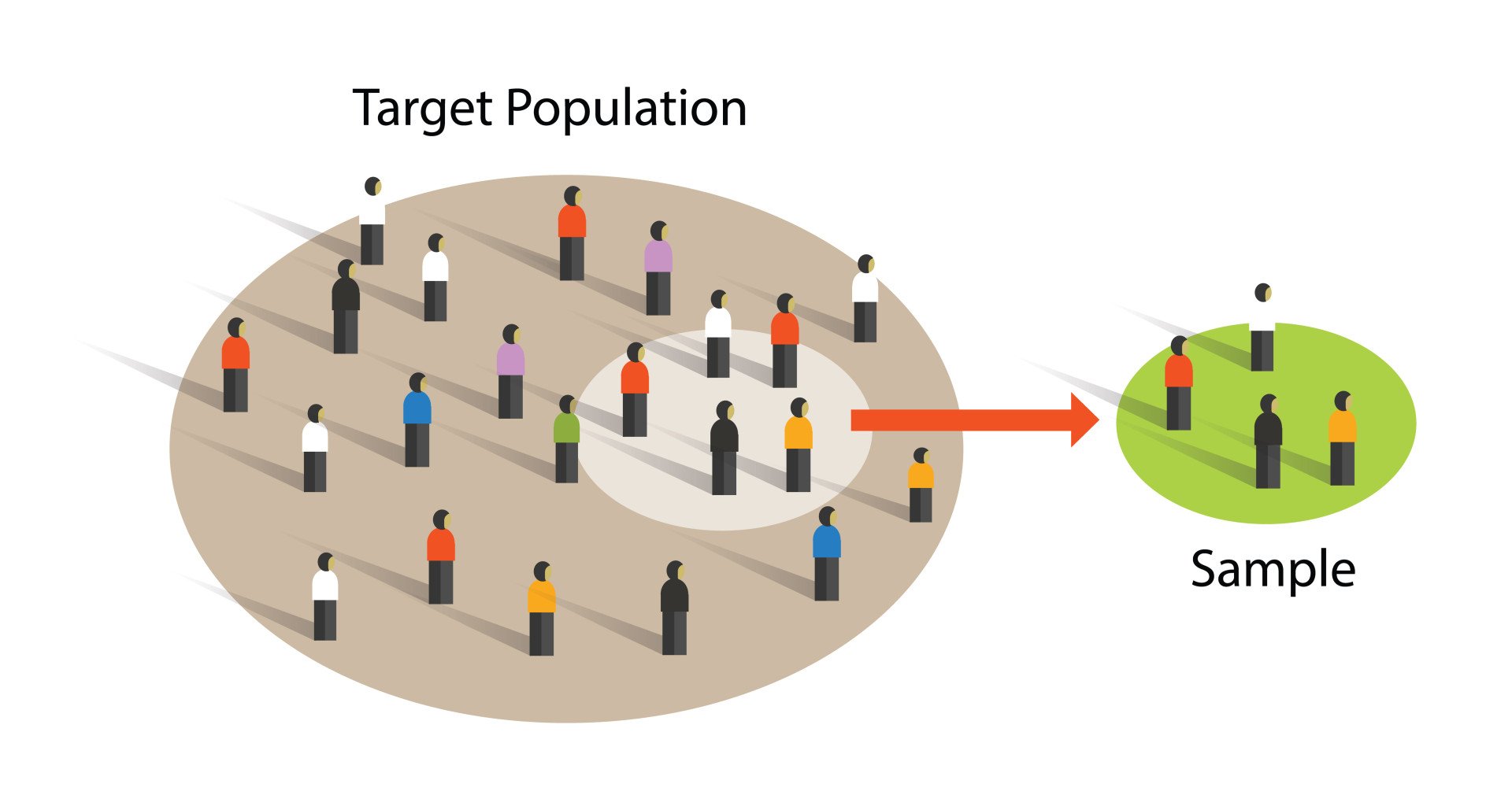Sampling bias occurs when a sample does not accurately represent the population being studied. This can happen when there are systematic errors in the sampling process, leading to over-representation or under-representation of certain groups within the sample.
Sampling bias results in biased samples of a population where all individuals were not equally likely to have been selected and thus do not accurately represent the entire group.
Sampling bias compromises the external validity of findings by failing to accurately represent the population, restricting the generalization of results only to groups that share characteristics with the sample.

In medical fields, sampling bias is ascertainment bias, where one category of participants is over-represented in the sample.
Sampling bias is problematic because it leaves out important research data, threatening external validity. The results from research completed with a sampling bias are misleading and exclude valuable data.
This limits the generalizability of your findings because findings from biased samples can only be generalized to populations that share characteristics with the sample. Thus the results from the research cannot be used to express the ideas and thoughts of the majority.
When there is sampling bias in your study, differences between the samples from a population and the entire population they represent are not due to chance but rather due to this bias.
Correcting or reducing sampling bias is important during the research because the population will not be accurately represented if the sample bias is not addressed.
It is important to note that sampling bias occurs during data collection and refers to the method of sampling, not the sample itself. Additionally, sampling bias often happens without the researcher’s knowledge.
Example
Imagine you want to study the prevalence of depression amongst undergraduate students at your university. You send out an email to the undergraduate student body asking for volunteers to participate in your study.
This method will lead to sampling bias because only the people who are open to talking about their depression will sign up to participate.
This is an example of voluntary response bias because only those individuals who are willing to talk about their experiences with depression will agree to take part in a study, making the participants a non-representative sample.
Types
Undercoverage Bias
Undercoverafe bias occurs when some population members are inadequately represented in the sample.
For example, administering a survey online will exclude groups with limited internet access, such as the elderly and those in lower-income households.
Voluntary Response Bias / Self-Selection Bias
Self-selection bias is a type of bias that occurs when participants can choose whether or not to participate in the project.
Bias arises because people with specific characteristics might be more likely to agree to participate in a study than others, making the participants a non-representative sample.
For example, people with strong opinions or substantial knowledge about a specific topic may be more willing to spend time answering a survey than those without.
Survivorship Bias
Survivorship bias refers to when researchers focus on individuals, groups, or observations that have passed some sort of selection process while ignoring those who did not.
In other words, only “surviving” subjects are selected. For example, in finance, failed companies tend to be excluded from performance studies because they no longer exist.
This causes the results to skew higher because only companies that were successful enough to survive are included.
Non-Response Bias
Non-response bias is a type of bias that arises when people who refuse to participate or drop out of a study systematically differ from those who take part.
For example, if conducting a study on the prevalence of depression in a community, your results may be an underestimation if those with depression are less likely to participate than those without depression.
Recall Bias
Recall bias occurs when some members of your sample cannot remember important details accurately. As a result, they might provide incomplete or incorrect information that can distort your research findings.
This type of bias tends to affect retrospective surveys that rely on self-reported data.
Exclusion Bias
This bias results from intentionally excluding a particular group from the sample. Exclusion bias is closely related to non-response bias.
Observer Bias
Observer bias refers to the tendency of observers not to see what is there, but instead to see what they expect or want to see.
This bias can result in an overestimation or underestimation of what is true and accurate, which compromises the validity of your research findings.
For example, researchers might unintentionally influence participants during interviews by focusing on specific statistics that tend to support the hypothesis instead of those that do not.
Causes
A common cause of sampling ties lies in the study’s design or the data collection process, as researchers may favor or disfavor collecting data from certain individuals or under certain conditions.
Sampling bias also tends to arise when researchers adopt sampling strategies based on judgment or convenience.
This type of bias can occur in both probability and non-probability sampling.
In probability sampling, every member of the population has an equal chance of being selected (i.e., using a random number generator to select a random sample from a population). While probability sampling tends to reduce the risk of sampling bias, it typically does not eliminate it completely.
Extracting random samples typically requires a sampling frame, or a list of units of the whole population from which the sample is drawn. However, using a sampling frame does not necessarily prevent sampling bias. If your sampling frame does not match the population, this can result in a biased sample.
This can happen when a researcher fails to correctly determine the target population or uses outdated and incomplete information, thus excluding sections of the target population.
Or, even when the sampling frame is selected properly, sampling bias can arise from non-responsive sampling units (i.e., if certain classes of subjects are more likely to refuse to participate).
Mismatches between the sampling frame and the target population, as well as non-responses, can result in a biased sample.
In non-probability sampling, samples are selected based on non-random criteria, such as with convenience sampling where participants are selected based on accessibility or availability.
These sampling techniques often result in biased samples because some population members are more or less likely to be included than others.
How to Avoid Sampling Bias
- Use random or stratified sampling → Stratified random sampling will help ensure you get a representative research sample and reduce the interference of irrelevant variables in your systematic investigation.
- Avoid convenience sampling → Rather than collecting data from only easily accessible or available participants, you should gather data from the different subgroups that make up your population of interest.
- Clearly define a target population and a sampling frame → Matching the sampling frame to the target population as much as possible will reduce the risk of sampling bias.
- Follow up on non-responders → When people drop out or fail to respond to your survey, do not ignore them, but rather follow up to determine why they are unresponsive and see if you can garner a response. Additionally, you should keep close tabs on your research participants, and follow up with them frequently to reduce attrition.
- Oversampling → Oversampling can be used to avoid sampling bias in cases where members of the defined population are underrepresented.
- Aim for a large research sample → The larger your sample population, the more likely you are to represent all subgroups from your population of interest.
- Set up quotas for each identified demographic → If you think participant gender, age, ethnicity or some other demographic characteristic is a potential source of bias within your study, quotas will allow you to evenly sample people from different demographic groups within the study.
FAQs
What is the difference between sampling bias and sampling error?
Sampling error is a statistical error that occurs when the sample used in the study is not representative of the whole population. So, sampling error occurs as a result of sampling bias.
What is the difference between sampling bias and response bias?
Sampling bias occurs when some members of a population are systematically more likely to be selected in a sample than others and thus the sample does not accurately represent the entire group.
Response bias is a general term that refers to a wide range of conditions or factors that can lead participants to respond inaccurately or falsely to questions.
For example, there could be something about how the actual survey questionnaire is constructed that encourages a certain type of answer, leading to measurement error.
Which type of sampling is most at risk for sampling bias?
Non-probability sampling, specifically convenience sampling, is most at risk for sampling bias because with this type of sampling, some members of the population are more likely to be included than others.
Does sampling bias affect reliability?
Yes, sampling bias distorts the research findings and leads to unreliable outcomes. It also is a threat to external validity because the results from a biased sample may not generalize to the population.
Why is it important to avoid sampling bias in research?
It is important to avoid sampling bias in research because otherwise, the population of interest will not be accurately represented. If the sample bias is not addressed then, your research loses its credibility.
Is probability sampling biased?
While probability sampling can significantly reduce sampling bias by
giving every member of the population an equal chance of being included in the research, this method can still result in a biased sample if your sampling frame does not match the population of interest.
Can sampling error be calculated?
Yes, sampling error is calculated by dividing the standard deviation of the population by the square root of the size of the sample, and then multiplying the resultant with the confidence level.
Here’s the formula for calculating sampling error:
Sampling error = confidence level × [standard deviation of population / (square root of sample size)]
Further Reading
Hamill, R., Wilson, T. D., & Nisbett, R. E. (1980). Insensitivity to sample bias: Generalizing from atypical cases. Journal of Personality and Social Psychology, 39(4), 578.
Nielsen, M., Haun, D., Kärtner, J., & Legare, C. H. (2017). The persistent sampling bias in developmental psychology: A call to action. Journal of Experimental Child Psychology, 162, 31-38.


